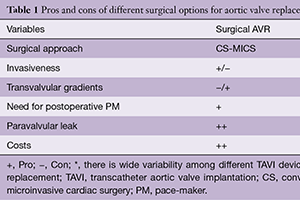Comparison of hemodynamic and clinical outcomes of transcatheter and sutureless aortic bioprostheses: how to make the right choice in intermediate risk patients
Abstract
Current surgical treatment options for aortic valve stenosis (AS), as alternative to that of conventional operation, are sutureless valve replacement (SUAVR) and transcatheter valve implantation (TAVI). Patients with high surgical risk, or those who are judged to be inoperable, are typically good candidates for the TAVI procedure. The best treatment option in patients with an intermediate risk profile, however, the so called “grey zone” is still currently under debate. Sutureless aortic valve replacement has been recently presented as a valid alternative for patients with low- to intermediate-risk. Data available on prostheses’ hemodynamic performance and patients’ clinical outcomes play a crucial role in the process of device selection. Compared to TAVI, SUAVR provides lower rate of significant postoperative paravalvular leak (PVL), which has shown to be predictor for mortality. On the contrary, transcatheter valves seem to perform better in terms of transvalvular mean and peak gradients. Therefore, SUAVR and TAVI are both reliable options in patients with severe aortic valve stenosis, alternative to conventional surgery, and the choice of the best device should be tailored on patient’s anatomical and surgical characteristics.
Cover






